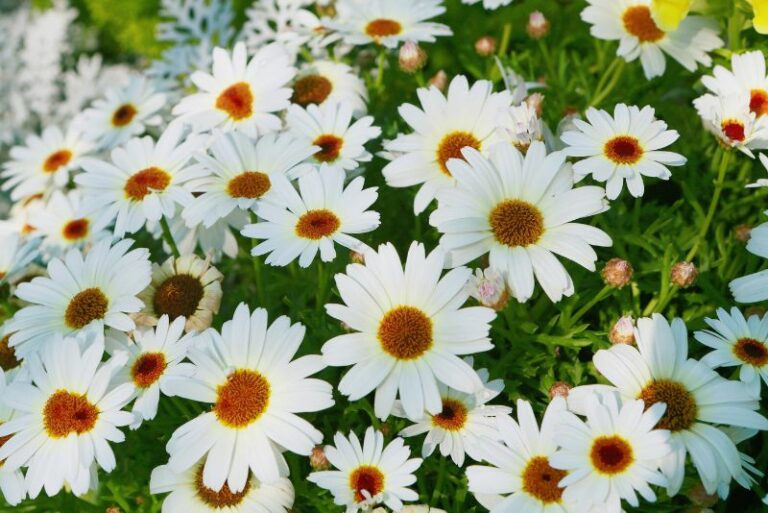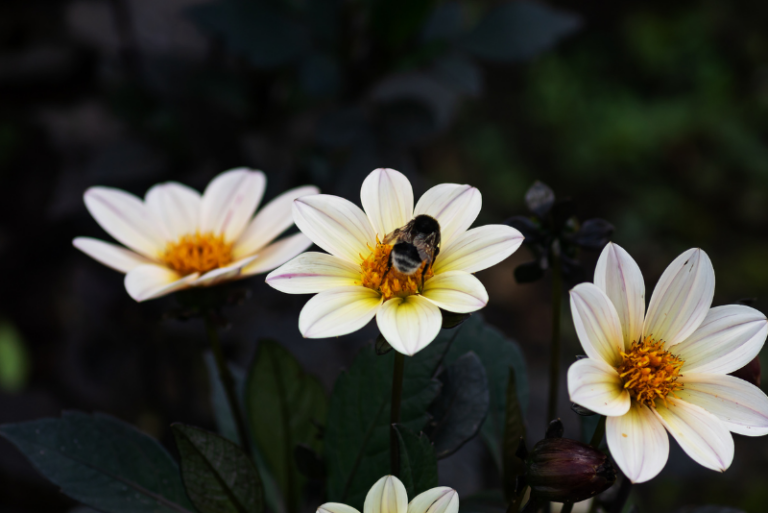Southern Blue Flag: How to Plant, Grow, and Care for Iris Virginica
As spring bursts across the American South, a humble yet striking flower begins to emerge from damp meadows, bogs and swamps – the Southern Blue Flag Iris. With sword-like leaves sometimes reaching over 3 feet in height and flowers ranging from deep indigo blue to pale lilac, this peculiar iris stands out amongst the verdant greenery awakening after a long winter’s rest.
For nature lovers seeking to incorporate this unique flower into their home landscape or expand an existing colony, the Southern Blue Flag is a visually impactful yet surprisingly low-maintenance native plant.
In this guide, I will cover everything you need to know to successfully grow and care for this special iris so you too can enjoy its vivid blooms heralding in the season of rebirth.
Southern Blue Flag Overview
| Features | Description |
|---|---|
| Common Name(s) | Southern Blue Flag, Harlequin Blueflag |
| Scientific Name | Iris virginica |
| Family | Iridaceae |
| Height | 2 to 3 feet |
| Light | Full sun to part shade |
| Water | Medium to wet |
| Soil | Prefers moist, acidic soils. Can tolerate clay, loamy, or sandy soil |
| Fertilizer | Not generally required, but a balanced fertilizer can be applied in spring |
| Pests and Diseases | Susceptible to iris borer, slugs, snails, and thrips; diseases may include bacterial soft rot, leaf spot, and crown rot |
Please note that this is a general overview. Specific care requirements might change based on your region and conditions. Always consult with a local nursery or extension service for the best practices in your area.
All About Southern Blue Flag

The Southern Blue Flag Iris, scientifically known as Iris virginica, is a perennial herb native to the eastern and southern regions of the United States. It thrives in USDA hardiness zones 5 through 9, making it a versatile option for a variety of climates.
Characterized by its sword-like leaves and striking blue-violet flowers, the Southern Blue Flag typically blooms from late spring to early summer. Its flowers, which can range from deep indigo to a softer lilac, have a unique, complex structure. Each flower consists of three downward-curving sepals, or “falls”, and three upright petals.
This unique iris prefers full sun but can tolerate partial shade. When it comes to soil, it prefers moist to wet conditions, making it an excellent choice for water gardens, bog gardens, or other damp areas in your landscape. It can also withstand poor drainage, which can be a challenge for many other plant species.
When it comes to care, the Southern Blue Flag Iris is a low-maintenance plant. Regular watering to keep the soil moist is key, and while it can tolerate poor fertility soils, adding a slow-release fertilizer once a year can promote healthier growth and more vibrant blooms.
Despite its robustness, this iris is not without its vulnerabilities. It can be affected by iris borers, slugs, snails, and certain types of plant viruses. Regular checks and early intervention can help keep these potential issues at bay.
As for propagation, the Southern Blue Flag can be grown from seeds or division. If you’re using seeds, they will need to be cold stratified before planting. Alternatively, dividing the rhizomes in late summer to early fall can help boost your colony’s growth.
In terms of wildlife, the Southern Blue Flag Iris has more to offer than just its visual appeal. Its nectar attracts a variety of pollinators, including bees and butterflies, making it an excellent choice for those looking to create a wildlife-friendly garden.
Ultimately, the Southern Blue Flag Iris is more than just a beautiful flower. It’s a resilient, low-maintenance plant that brings a unique aesthetic to any landscape, as well as a valuable addition to a wildlife-friendly garden. With the right care, it can thrive and bring color and life to your outdoor space season after season.
Varieties of the Southern Blue Flag Iris
The Southern Blue Flag Iris, much like other species of Iris, comes in multiple varieties, each with its unique attributes and characteristics. Let’s delve into the history, appearance, scent, and similarities of these varieties.
1. Iris virginica var. shrevei
Historically, this variety is native to Midwestern regions of the United States. The Shreve’s Iris is a hardy plant that can tolerate a wide range of conditions. It showcases the characteristic deep indigo to lilac flowers that are typical of the Southern Blue Flag species, although its petals are generally wider. The scent of Iris virginica var. shrevei is delicately sweet, attracting a myriad of pollinators. It shares the wetland preference and the sword-like foliage with other varieties of Southern Blue Flag Iris.
2. Iris virginica var. virginica
Known as the coastal iris, this variety is native to the coastal regions of the Eastern United States. Iris virginica var. virginica boasts flowers in the most striking shades of violet-blue and has narrower petals compared to other varieties. It possesses a mild, pleasing fragrance that adds to its charm. Similar to its siblings, it thrives in wet, marshy areas and has the same low-maintenance appeal.
3. Iris virginica var. smalliana
This variety, often referred to as Small’s iris, is predominantly found in the Southeastern United States. With smaller, more intricately-veined petals, its flowers present a distinct appearance. The scent is light and refreshing, contributing to its overall appeal. Iris virginica var. smalliana, like its counterparts, displays a similar preference for moist, wetland environments.
In conclusion, while each variety of the Southern Blue Flag Iris carries its unique features, they all share common elements – vibrant, blue-violet blooms, a distinct scent, low-maintenance nature, and the preference for wetland habitats. Each variety offers its unique touch of elegance, making them perfect for enhancing the visual appeal of your garden.
Southern Blue Flag Care Procedures
In order for your Southern Blue Flag Iris to thrive and provide you with its stunning blooms year after year, it’s essential to follow a proper care routine. Here are some essential guidelines to keep in mind:
Light and Temperature
Iris virginica, or the Southern Blue Flag Iris, thrives best in full sun, enjoying at least six hours of direct sunlight a day. This exposure to abundant light helps to ensure vigorous growth and vibrant, prolific flowering. However, it’s worth noting that in hotter climates, this iris can also tolerate partial shade, especially during the intense heat of the afternoon.
In terms of temperature, the Southern Blue Flag Iris is quite resilient and versatile. It can comfortably grow in USDA hardiness zones 5 through 9. This means it can withstand winter lows down to -20 degrees Fahrenheit (-29 degrees Celsius) and summer highs up to 90 degrees Fahrenheit (32 degrees Celsius). However, it is crucial to monitor extreme weather conditions, particularly intense heat in the summer. During such periods, ensure the plant has adequate shade and water to prevent wilting or burning.
Remember, while the Southern Blue Flag Iris is a robust and adaptable plant, maintaining optimal light and temperature conditions will not only contribute to its overall health but significantly enhance its aesthetic appeal.
Water and Humidity
The Southern Blue Flag Iris is an extremely water-loving plant, which makes it a suitable candidate for water gardens or soggy areas where other plant species may struggle. It prefers consistently moist or even wet soil conditions. During the growing season, regular watering is essential. Aim to water these irises deeply, ensuring the water reaches the roots, but avoid water standing around the plant which could cause root rot.
In terms of humidity, the Southern Blue Flag Iris is adaptable and can grow in different humidity conditions. However, it prefers high humidity, which is typical of its native wetland habitats. If you’re growing this plant in a dryer environment, try to recreate its natural habitat by regularly misting the leaves with water to increase the humidity around the plant.
Keep in mind that while this plant loves water, proper drainage is also important to prevent waterlogging. If you’re planting it in a pot, make sure the pot has sufficient drainage holes. If it’s planted in the ground, the soil should be wet but well-drained. Remember, the goal is to keep the soil consistently moist, not waterlogged.
Remember that these water and humidity preferences can be subject to change based on the specific variety of Southern Blue Flag Iris you have, so do some research or consult with a gardening expert to make sure you’re providing optimal care for your specific plant. With the right water and humidity conditions, your Southern Blue Flag Iris will thrive, providing you with its stunning, vibrant flowers each season.
Soil Type, pH, and Preparation
The Southern Blue Flag is tolerant of various soil types, including clay, loam, and sandy soil. However, it thrives best in rich, organic soils that retain moisture well. This is in tune with its natural wetland habitat where the soil is often nutrient-dense and moist.
As for pH, the Southern Blue Flag Iris is somewhat flexible and can grow in mildly acidic to mildly alkaline environments. The optimal pH range for this plant is between 5.5 and 7.5. Outside of this range, the plant may exhibit signs of nutritional deficiency or may have difficulty absorbing nutrients from the soil.
Preparing the soil for your Southern Blue Flag Iris involves several steps:
Soil Testing: Before planting, it’s beneficial to conduct a soil test. This will give you an understanding of what nutrients your soil already contains and its pH level. If the pH is not within the optimal range, you can make appropriate amendments.
Amend the Soil: If your soil is low in organic matter, consider amending it with well-rotted compost or manure. These additions will enrich the soil and enhance its water-holding capacity, which is beneficial for water-loving plants like the Southern Blue Flag Iris.
Adjust Soil pH (if necessary): If your soil test results indicate that the pH is too high or too low, you would need to adjust it. To increase soil pH, you can add garden lime. To decrease soil pH, add sulfur or a soil acidifier.
Prepare the Planting Site: Dig a hole that’s about twice the size of the root ball of your iris. The hole should be deep enough to accommodate the rhizome, which should be situated just below the soil surface.
Plant and Water: Place the iris in the hole, backfill with soil, firm it gently around the roots, and water thoroughly. The top of the rhizome should be visible at the soil surface.
Remember, while the Southern Blue Flag Iris is relatively easy to grow, providing it with a suitable soil environment will significantly enhance its growth, health, and flowering capacity.
Fertilizer Care Procedures for Southern Blue Flag Iris
Fertilizing your Southern Blue Flag Iris is an essential part of its overall care routine, crucial for promoting lush growth and vibrant blooms. Here’s a step-by-step guide to fertilizing your Southern Blue Flag Iris:
Choose the Right Fertilizer: Start by selecting a balanced, slow-release fertilizer. A fertilizer with an NPK ratio of 10-10-10 or 14-14-14 is typically suitable, supplying equal amounts of Nitrogen, Phosphorous, and Potassium – all essential nutrients for plant growth.
Timing: Fertilize your iris in early spring before new growth begins, and then again after blooming has finished. This timing helps the plant absorb nutrients when it needs them most, encouraging a healthy growth cycle.
Application: Apply the fertilizer according to the package instructions. Fertilizers can vary in strength, so it’s essential to follow the manufacturer’s guidelines to avoid over-fertilization, which can damage your plant. Typically, you’ll want to sprinkle the fertilizer around the base of the plant, avoiding the foliage to prevent leaf burn.
Watering: After applying the fertilizer, water the plant thoroughly. This helps to dissolve the fertilizer and carry it down to the iris’s roots, where it can be absorbed.
Monitor Your Plant: Keep an eye on your Southern Blue Flag Iris after fertilizing. Healthy, well-fertilized iris plants will display deep green foliage and robust blooms. If you notice yellowing leaves or stunted growth, it may indicate a nutrient deficiency, and additional fertilization might be necessary.
Remember, as with any plant, it’s crucial not to over-fertilize your Southern Blue Flag Iris. Too much fertilizer can lead to salt build-up in the soil, which can harm your plant. Always follow the recommended rates and intervals for fertilizer use. With correct fertilizing practices, your Southern Blue Flag Iris will continue to grow vigorously and produce stunning blooms.
Southern Blue Flag Iris Care Procedures for Repotting
Repotting the Southern Blue Flag Iris is an important part of plant care. It can rejuvenate a crowded plant, give it more room to grow, and refresh the nutrient content of the soil. Here’s a detailed guide:
Choose the Right Time: The best time to repot your Southern Blue Flag Iris is in late summer or early fall, after it has finished blooming for the year. This timing allows the plant to establish itself in its new pot before the onset of winter.
Select a Suitable Pot: Choose a pot that is larger than the current one and has ample drainage holes. The pot should be large enough to accommodate the plant’s growth for the next few years.
Step 3: Prepare the Pot: Fill the pot with a mix of rich, well-draining soil and compost. This will provide your Southern Blue Flag Iris with the nutrients it needs to flourish.
Remove the Iris from its Current Pot: Gently loosen the soil around the edges of the pot, turn it sideways, and ease the plant out, taking care not to damage the rhizome or roots.
Trim and Inspect the Iris: Inspect the iris for any signs of disease or pest infestation. Trim any damaged or diseased roots or foliage.
Place the Iris in the New Pot: Position the iris in the center of the new pot. The rhizome should be level with or slightly above the soil surface, as burying the rhizome can lead to rotting.
Fill and Water: Fill in with soil around the roots, firming gently. Water the plant thoroughly and place it in a location where it will receive its preferred sunlight exposure.
Remember, repotting can be a shock to plants, so it’s important to give your Southern Blue Flag Iris a little extra care after repotting. Keep the soil evenly moist and avoid over-fertilization until you see new growth, indicating that the plant has adjusted well to its new pot. With these steps, your Southern Blue Flag Iris should transition smoothly to its new home and continue providing beautiful blooms for years to come.
Southern Blue Flag Iris Propagation Guide
Propagating the Southern Blue Flag Iris can be done in several ways, including division, cuttings, or seeds. Each method has its own advantages and specific steps to follow for successful propagation. Here’s a detailed walkthrough of each propagation method:
1. Division:
Division is a simple method of propagation, particularly useful when your plant has become overcrowded or you wish to share it with others. Here’s the step-by-step process:
- Choose the Right Time: Divide your Southern Blue Flag Iris in late summer or early fall, after blooming has finished for the year.
- Remove the Iris: Carefully dig up the plant, being cautious not to damage the rhizomes.
- Divide the Rhizomes: Gently separate the rhizomes with your hands. Each division should have a fan of leaves and a healthy section of rhizome.
- Plant the Divisions: Replant the divisions in prepared soil, ensuring the top of each rhizome is visible at the soil surface.
Cuttings:
Propagating from cuttings is another viable method. Here’s the process:
- Choose the Right Time: Take cuttings from your Southern Blue Flag Iris in early summer.
- Prepare the Cutting: Select a healthy leaf and cut a 3-4 inch section from the end. The cutting should have a fan of leaves at the top.
- Plant the Cutting: Place the cutting in a pot of moist soil, burying it about 1 inch deep.
- Care for the Cutting: Keep the soil moist and place the pot in a location with indirect light. Roots should develop within a few weeks.
3. Seeds:
Growing this iris from seeds can be a rewarding process, though it takes the longest. Here’s how:
- Sow the Seeds: In late winter, sow the seeds on the surface of a pot filled with seed compost. Cover the seeds lightly with compost.
- Provide Proper Conditions: Place the pot in a cold frame or unheated greenhouse. Keep the compost moist but not waterlogged.
- Germination: Seeds can take several weeks to germinate. Once seedlings are large enough to handle, transplant them into individual pots.
- Grow On: Let the plants grow on in a cold frame until they’re large enough to plant outdoors.
Remember, propagation success can vary depending on the method chosen and the conditions provided. With patience and care, your efforts can result in new Southern Blue Flag Iris plants that will enhance your garden with their stunning blooms.
Southern Blue Flag Iris Care Procedures for Pruning
Pruning your Southern Blue Flag Iris is an essential aspect of its care. This practice helps maintain the plant’s health, promotes better blooming, and keeps it looking tidy. Here’s a step-by-step guide to help you prune your Southern Blue Flag Iris:
1. Choose the Right Time:
The best time to prune your Southern Blue Flag Iris is after flowering, usually in late summer or early fall. This timing allows the plant to recover before the next bloom cycle.
2. Prepare Your Tools:
Ensure you have sharp, sterilized pruning shears or scissors. Sterilizing your tools reduces the risk of transmitting diseases to your plant.
3. Remove Spent Blooms:
Identify spent or faded blooms on your iris plant. Cut off these blooms at their base, which will redirect the plant’s energy to the rhizome for next year’s growth.
4. Trim Leaves and Stalks:
Look for leaves that are brown, wilted, or showing signs of disease or pest damage. Trim these back to the base of the plant. Cut back flower stalks to about 5-6 inches above the rhizome after all flowers have faded.
5. Inspect and Treat:
Once pruning is done, inspect the plant for any signs of pests or diseases. Treat any issues promptly to avoid further spread.
6. Dispose of Debris:
Be sure to clean up and dispose of all plant debris. Leaves and spent blooms can harbor diseases and pests over winter.
Remember, proper pruning is integral to maintaining a healthy and vigorous Southern Blue Flag Iris. By following these steps, your iris will be able to conserve its energy for robust blooming in the next season.
Troubleshooting
Every gardener encounters challenges when growing plants, and the Southern Blue Flag Iris is no exception. However, identifying common problems and knowing how to address them can ensure your iris thrives. This troubleshooting guide will help you diagnose and resolve common issues related to growing problems, pests, and diseases.
Growing Problems
Iris plants can exhibit signs of stress or poor health due to various growing issues. These can include yellowing leaves, lack of bloom, or wilting. Often, these issues stem from factors like improper watering, poor soil conditions, or inadequate light. Overwatering or underwatering can cause the leaves to turn yellow or wilt. Similarly, poor soil conditions, such as heavy clay or poorly-draining soils, can lead to root rot. Lastly, Southern Blue Flag Iris needs full sun to partial shade for optimal growth. Too much shade can result in sparse or non-existent blooms.
Pests
The Southern Blue Flag Iris may also be affected by common garden pests such as aphids, slugs, and snails. Aphids, tiny green or black insects, can cause the leaves to curl, yellow, and become distorted. Slugs and snails can chew large holes in the leaves. Regular inspection of your plants can prevent minor infestations from becoming major ones. Treatments include hand-picking, using slug traps, or applying insecticidal soap or neem oil.
Diseases
Southern Blue Flag Iris is relatively disease-resistant but can sometimes suffer from root rot or iris borers. Root rot, usually a result of poor drainage or overwatering, can cause the plant to yellow, wilt, and even die. Iris borers are caterpillars that bore into the rhizomes, causing significant damage. Unfortunately, plants with severe root rot or borer infestations are often best discarded to prevent the spread of disease. Prevention methods include proper watering, good cultivation practices, and regular plant inspection.
Remember, most issues can be prevented with proper care — suitable sunlight, well-draining soil, optimal watering, and regular plant check-ups. With these practices, you can ensure your Southern Blue Flag Iris remains healthy and vibrant.
Frequently Asked Questions about Southern Blue Flag Iris
Here are some common questions that gardeners have about the Southern Blue Flag Iris, along with their answers:
1. Can Southern Blue Flag Iris grow in shade?
While the Southern Blue Flag Iris prefers full sun to partial shade, it can tolerate a bit of shade. However, too much shade can result in sparse or non-existent blooms.
2. How often should I water my Southern Blue Flag Iris?
Watering requirements can vary based on climate and soil type, but generally, the soil should be kept moist but not waterlogged. It’s important to avoid both underwatering and overwatering, as both can lead to health issues for the plant.
3. What type of soil is best for Southern Blue Flag Iris?
Southern Blue Flag Iris prefers well-draining soil. Heavy clay or poorly-draining soils can lead to root rot.
4. How can I protect my Southern Blue Flag Iris from pests and diseases?
Regular inspection and good cultivation practices can help prevent pest infestations and disease. If you notice any issues, treat them promptly to avoid further spread.
5. When is the best time to prune Southern Blue Flag Iris?
The best time to prune your Southern Blue Flag Iris is after flowering, usually in late summer or early fall. This allows the plant to recover before the next bloom cycle.






